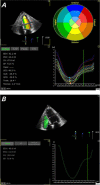Artificial Intelligence in Echocardiography
- PMID: 35481864
- PMCID: PMC9053659
- DOI: 10.14503/THIJ-21-7671
Artificial Intelligence in Echocardiography
Abstract
Artificial intelligence in diagnostic cardiac-imaging platforms is advancing rapidly. In particular, artificial intelligence algorithms have increased the efficiency and accuracy of echocardiographic cardiovascular imaging, resulting in more complex echocardiographic imaging techniques and expanded use among noncardiologists. Here, we provide an overview of real-world applications of artificial intelligence in echocardiography including automatic high-quality computer-optimized image acquisition sequences, automated measurements, and algorithms for the rapid and accurate interpretation of cardiac physiology. These advances will not replace physicians but will improve their productivity, workflow, and diagnostic performance.
Keywords: Algorithms; artificial intelligence; cardiac imaging techniques/methods; deep learning; diagnosis, computer-assisted; echocardiography; image interpretation, computer-assisted; imaging, three-dimensional; investigative techniques.
© 2022 by the Texas Heart® Institute, Houston.
Conflict of interest statement
Figures


References
-
- Behnami D, Liao Z, Girgis H, Luong C, Rohling R, Gin K . Dual-view joint estimation of left ventricular ejection fraction with uncertainty modelling in echocardiograms. In: Shen D, Liu T, Peters TM, Staib LH, Essert C, Zhou S, editors. Medical Image Computing and Computer Assisted Intervention – MICCAI 2019. Cham: Springer: 2019. pp. 696–704. Lecture Notes in Computer Science (vol. 11765) p.
MeSH terms
LinkOut - more resources
Full Text Sources

